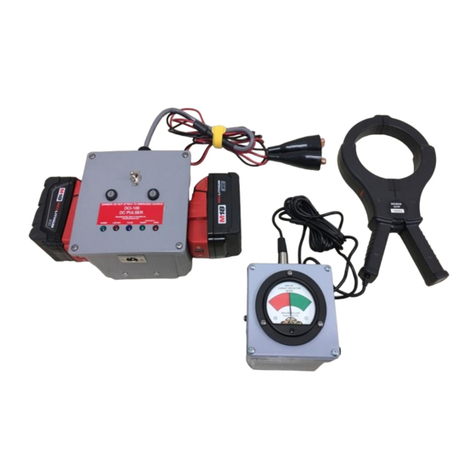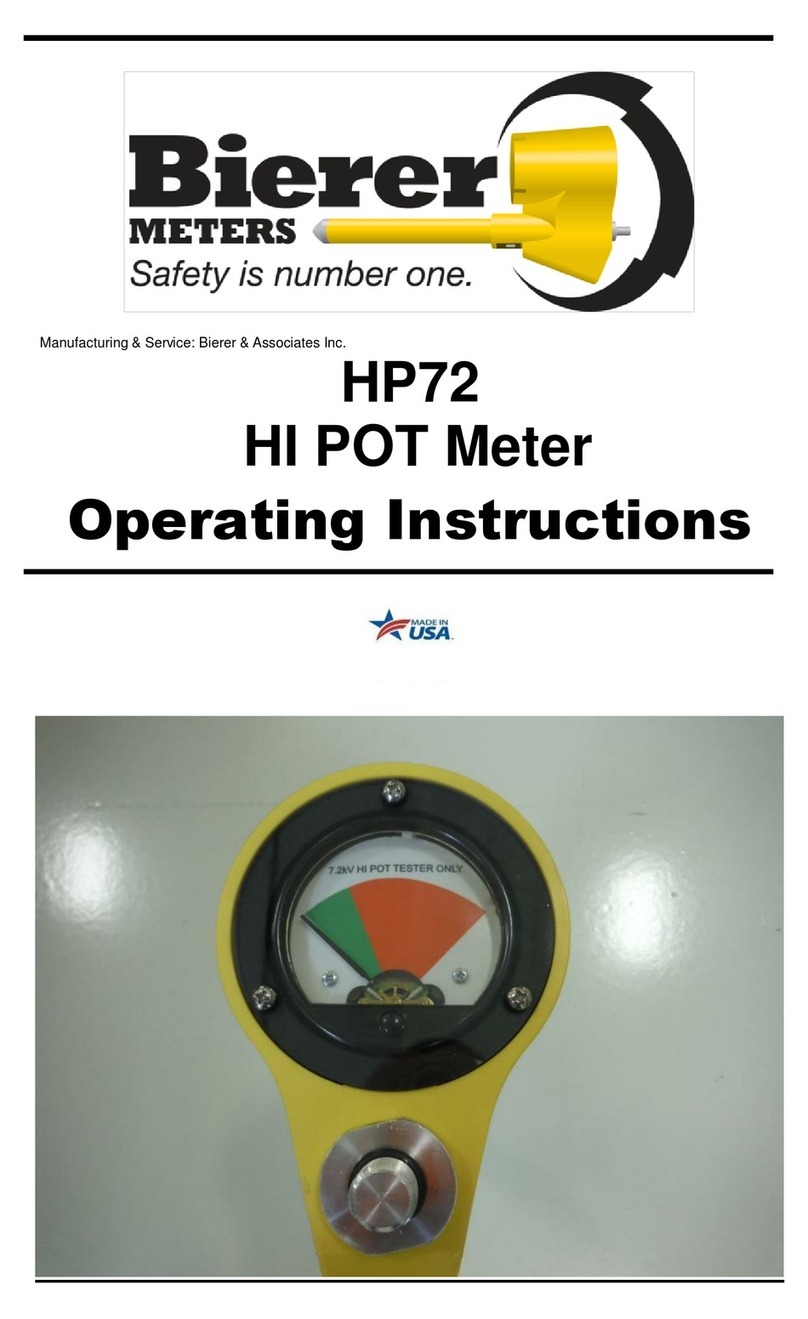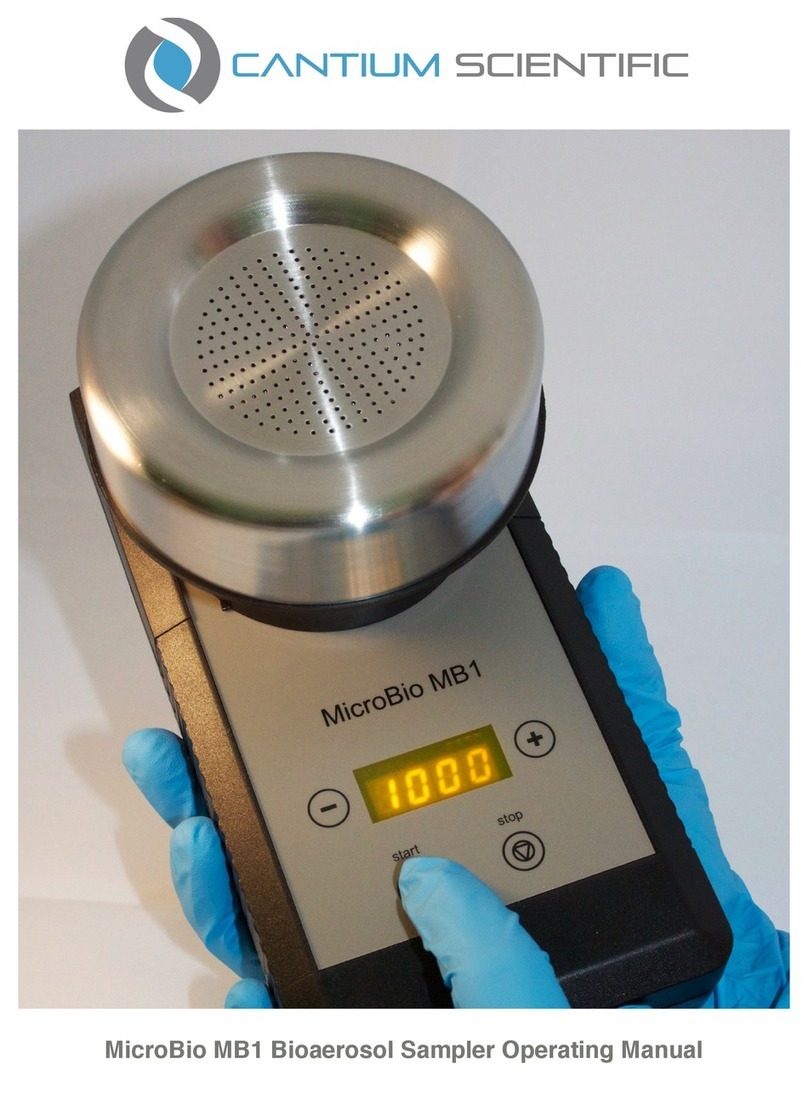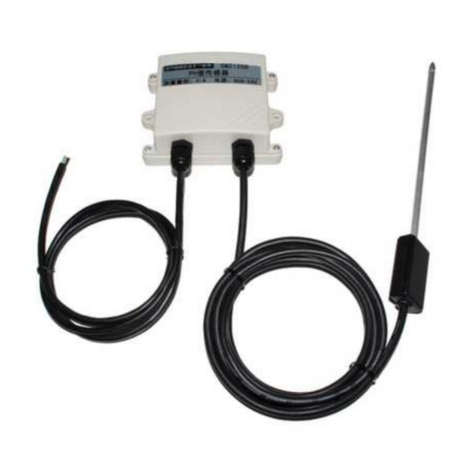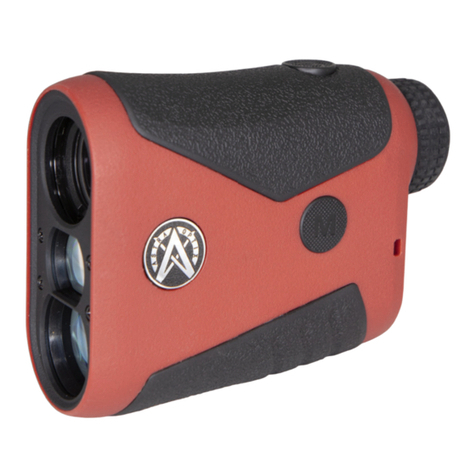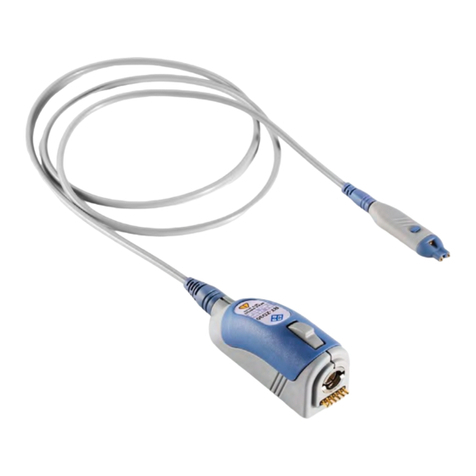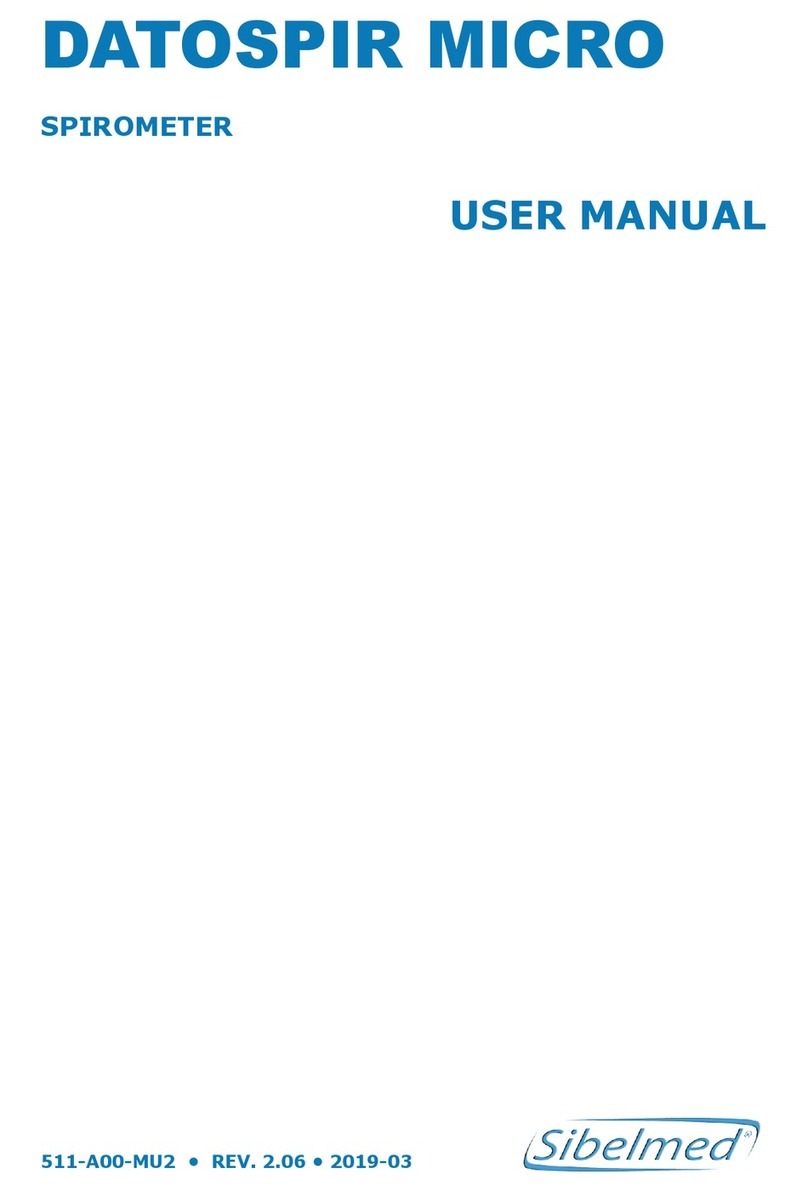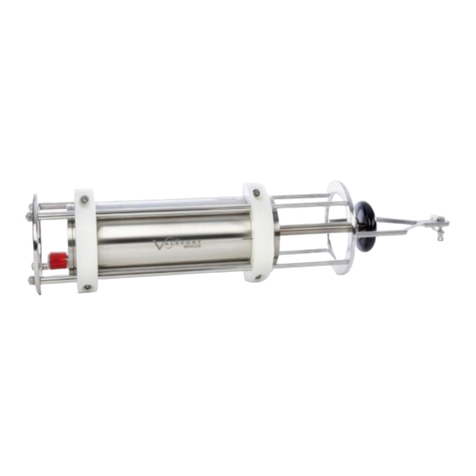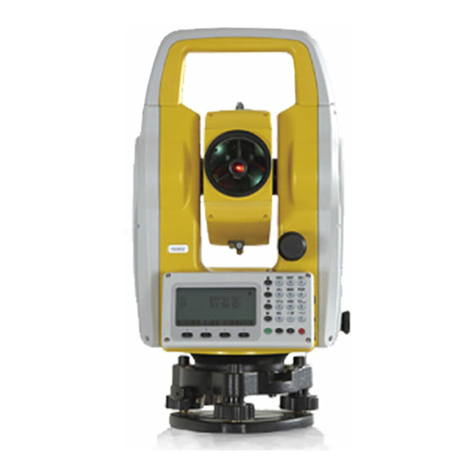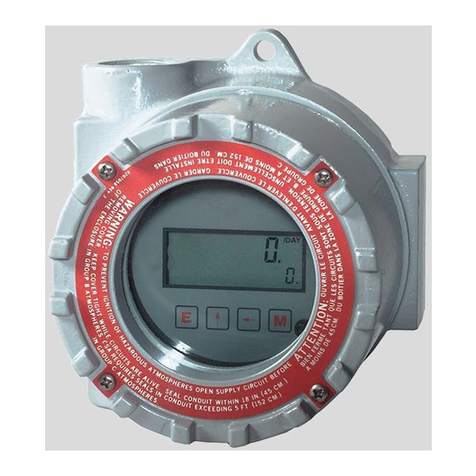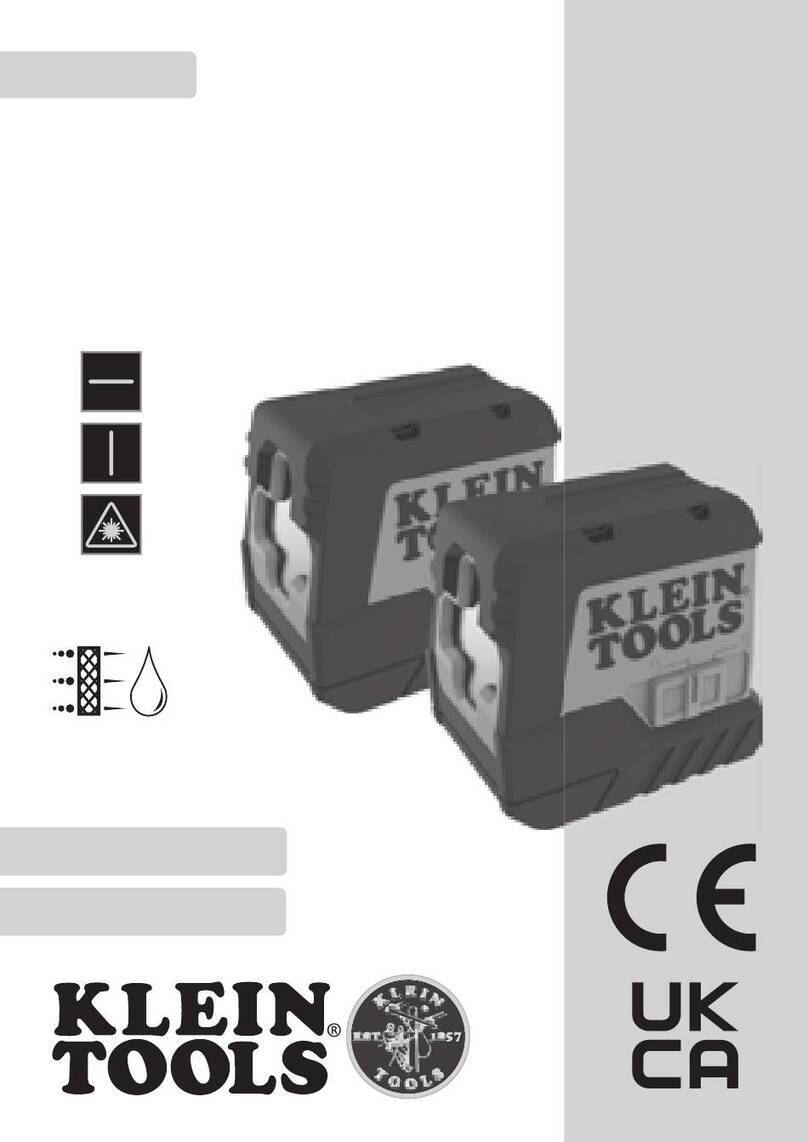Bierer Phasing Ranger 2 User manual

Phasing Ranger 2™
Long Distance
Phasing System
Operating Instructions
Patent No. 6,617,840 and 6,734,658

2
CONTENTS
Limitation of Warranty and Liability 3
Product Safety Information 4
Design and Function 5
Meter Probe Set-up and Testing 7
Send Unit Set-up and Testing 8
Receive Unit Set-up and Testing 9
Phase Angle Measurements 10
Testing Phase Sequence 12
FCC Compliance Information Statement 13
Parts & Accessories 14
Notes 15
For Training, Support, or Any Questions
Concerning the use of the
Phasing Ranger 2
or the Information In This Manual
Feel Free to call us at (803)786-4839

3
Limitation of Warranty and Liability
Bierer & Associates Inc. warrants this product to be free from defects in
workmanship and material, under normal use and service conditions for a
period of one year from date of shipment.
Due to continuous product improvement and development, Bierer & Associates
Inc. reserves the right to modify product designs and specifications without
notice.
It is impossible to eliminate all risks associated with the use of high voltage
electrical devices including this device. Risks of serious injury or death are
inherent in working around energized electrical systems. Such risks include but
are not limited to variations of electrical systems and equipment, manner of use
or applications, weather and environmental conditions, operator mentality, and
other unknown factors that are beyond the control of Bierer & Associates Inc.
Bierer & Associates Inc. do not express or imply to be an insurer of these risks,
and by purchasing or using this product you AGREE TO ACCEPT THESE RISKS. IN
NO EVENT SHALL Bierer & Associates Inc. BE LIABLE FOR ANY INCIDENTAL,
CONSEQUENTIAL OR SPECIAL DAMAGES RESULTING FROM THE USE OR
HANDLING OF THIS PRODUCT.
SAFETY MESSAGE DEFINITIONS per ANSI Z535
These instructions contain important safety messages to alert the user to
potentially hazardous situations, how to avoid the hazard, and the
consequences of failure to follow the instruction.
The safety alert symbol identifies a safety message. The signal word
following the symbol indicates:
DANGER A hazardous situation which, if not avoided, will result in
death or serious injury and equipment damage.
WARNING A hazardous situation which, if not avoided, could
result in death or serious injury and equipment damage.
CAUTION A hazardous situation which, if not avoided, could
result in minor or moderate injury and equipment damage.
NOTICE Important safety message relating to equipment damage
only.

4
PRODUCT SAFETY INFORMATION
WARNING
1. Meter assembly, interconnect cable assembly, and live line tool
adapters shall be considered non-insulating. Do not let live line tool
fittings come in contact with energized or grounded conductors. The
live line tool adapters, fittings, and handles supplied with meters
shall not be used on any other devices.
2. Use appropriate length live line tools for voltage being worked and
maintain minimum approach distances as outlined in OSHA
1910.269, Table R-6.
3. All Phasing Meters and Voltage Detectors manufactured during and
after 2007 will have a limit mark engraved on the high voltage
probe(s) 2.5 inches from the tip to indicate to the user the physical
limit that should not be exceeded when approaching and contacting
an electrical conductor or other electrical test points. Zero Ohm
insulated adapters (81280IE) should be used if limit mark will be
exceeded.
4. This equipment should be used only by qualified employees, trained
in and familiar with the safety-related work practices, safety rules
and other safety requirements associated with the use of this type
of equipment.
5. These instructions are not intended as a substitute for adequate
training, nor do they cover all details or situations which could be
encountered when operating this type of equipment.
6. Before operating this equipment, read, understand and follow all
instructions contained in this manual. Keep instructions with
equipment.
INSPECTION & MAINTENANCE BEFORE USE
WARNING
1. Prior to using any high voltage test equipment a careful inspection
should be made to ensure the unit is free from any contaminants
such as dirt, grease, etc. and that there are no apparent physical
damages.
2. High voltage probe assemblies shall be wiped clean prior to each use
with a silicone impregnated cloth and kept clean and free of
contaminants. This will prevent tracking on the outside of the probe
and meter error.
3. Always confirm internal battery voltage before and after each use.
4. Unit shall be tested before and after each use on a known voltage
source. Failure to do so could result in false negative indications

5
Design and Function
WARNING
Limit Mark -see “Product Safety Information”, item 3, page 4.
The Phasing Ranger 2 is designed to operate in conjunction with the Cordless
PD800W Meter Probe only. The unit consists of two main devices; a Send Unit
and a Receive Unit. The Send Unit plugs into a standard 115V AC wall outlet
and a land line telephone outlet via a standard telephone cord (provided). The
Receive Unit is power by rechargeable batteries and a cell phone via an audio
cable or the more convenient Bluetooth Connection using you Bluetooth
enable phone. There is an ac power or dc power cable to charge the battery
when it is low for either in a building or out on the road in a truck. The Receive
Unit talks directly to the Meter Probe to provide the correct phase angle. The
Phasing Ranger 2 is useable from 120/208 V to 800kV at a tested distance of
1000 miles.
Each unit has an On-Off switch, a red Power light, a red charging light (Field
unit only), and a white Data light. A Solid red power light indicates power
supply voltage is good, a Blinking red power light indicates power supply
voltage is low, and No red power light indicates too low or no power supply
voltage. A solid red charging light indicates the unit is plugged in to a good
charging source ad charging the batteries. No Red charging light indicates there
is no charging voltage present. A Solid white light indicates satellite data and
phase angle data is good, a slow blinking (1 pulse per second) white light
indicates satellite data is good but phase angle data is not present, and No
white light indicates data is not available.

6
PD800W Meter Probe (DEG Position ONLY)
DEG – Phase angle measurement in degrees for use on Secondary, URD and
Overhead. Direct contact from 240V to 69kV (including capacitive test points).
Non-contact from 69kV to 800kV.
T – Tests basic meter function and displays the internal 9V battery voltage.
0 degree light - indicates an in-phase condition relative to send unit
120 degree light - indicates out-of-phase condition of 120 degrees.
240 degree light - indicates an out-of-phase condition of 240 degrees.
Yellow “DY” - blinking light indicates a Delta/Wye transformation (30 degree or
greater phase shift) in conjunction with one of the other three phase indicator
lights.
NOTE1: A reading less than 07.0 in the test position indicates low battery.
Replaceable 9V battery is located behind the live line tool attachment threaded
into the meter housing just below the battery label on the display side of the
meter.
WARNING
Unit shall be tested before and after each use on a known voltage source.
Failure to do so could result in false negative indications.

7
METER PROBE SET-UP & TESTING:
WARNING
See “Product Safety Information”, page 4.
See “Inspection & Maintenance”, page 4.
The Meter Probe completes a self-check each time the selector switch is moved
from one position to another. It displays the number 510 and blinks 0, 120, 240
phase sequence indicator lights followed by a blinking D/Y (Delta/ Wye
Transformation) indicator light. The internal 9V battery voltage should be
checked by turning the rotary selector switch to the T position and holding for
several seconds until the indicator lights stop blinking. If the battery voltage
displayed is less than 7.0 volts, shown on the meter as 07.0, the battery should
be replaced. A standard 9-volt battery is located behind the live line tool
attachment just below the battery label.
WARNING
Unit shall be tested before and after each use on a known voltage source.
Failure to do so could result in false negative indications.
TESTING PD800W METER PROBE ON KNOWN VOLTAGE:
1. Turn the unit to the test position and verify a god battery voltage level.
2. Turn the selector switch back to URD position.
3. Turn on the known voltage source, Bierer offers several options, but we’ll
be using the 3kV power supply and Handheld Power Supply for this.
4. Attach appropriate length live line tool attachment.
5. If using the 3kV power supply, with the tip of the meter, depress the plunger
switch.
6. If using the Handheld Power Supply, hold down the power button and make
contact with the metal disc at the end of the tester.
7. An indication above 3kV on either tested indicates the unit is good.
Readings will vary depending on proximity to ground sources.
8. Turn the power supply off and return to their storage containers.
9. Meter is now ready for use.
Note: if your PD800W meter probe is part of a PD800W set, you can also a Dual
Phase Power Supply to perform this test. See the PD800W Instruction Manual
page 6 for that test.

8
SEND UNIT SET-UP & TESTING:
1. Permanently place satellite receiver (GPS) where there is a clear view of the
sky, i.e. a window sill (non-tinted), preferably outside on the building
structure with a minimum distance of 16 inches from the wall.
2. Attach Auto Answer Device to Send Unit labeled “TO AUTO ANSWER
DEVICE” via audio cable then attach Auto Answer Device to a telephone
outlet.
3. Plug in wall adapter into any 115 VAC standard outlet and plug other end
into Send Unit labeled “AC IN 15V MAX”. It is Very important that this
adapter is not removed or rotated from this outlet, this is your Reference
Phase information. If the unit is ever moved or you notice your
measurements have shifted, repeat his procedure to align your base unit
again.
4. Turn switch to the ON position, both lights will alternatingly blink between
red and white and then the red light (Power) should remain on. The white
may remain on for a few seconds but then go out again.
5. Within several minutes the white light (1PPS Data) should go solid.
6. The Send Unit is now ready to receive calls.
7. Now set-up the Receive Unit before continuing to step 8.
8. Turn on the Meter Probe (PD800W) and turn to the “DEG” position ONLY.
9. Make Direct contact with a known phase, i.e. “A, B or C” phase, “1, 2, or 3”
phase.
10. If a 120-degree reading is expected while making direct contact but the
Meter Probe displays something different, you will need to adjust the
“Degrees Offset” binary switches (All defaulted UP) by switching down the
degrees to subtract from your current reading. For example, if you expected
120 but got 200, you would switch down the 64 and 16 switches. If you
expected 120 but got 90, you would switch down the 256, 64, 8, and 2.
Some small adjustments may have to be made till you get the desired
reading. Now your base unit is set-up to phase.

9
RECEIVE UNIT SET-UP & TESTING:
WARNING
See “Product Safety Information”, page 4.
See “Inspection & Maintenance”, page 4.
1. Place the Field Unit in a location where there is a clear view of the sky
(dashboard of automobile is suitable).
2. Turn switch to the ON position, both lights (Red Power and White 1PPS
Data) should blink momentarily and then the red light (Power) should
remain on. If the red light continues to blink or does not stay on, batteries
are low and you will need to either plug it in to use or plug it in to charge
before use.
3. Within several minutes the white light (1PPS Data) should begin blinking at
1 pulse per second. This will indicate a clear satellite signal is synced.
4. Using a cellular phone, connect to the unit with either an audio cable or
through your phones Bluetooth. In order to link via a Bluetooth connection,
ensure your phone has its Bluetooth turned on. From the dropdown menu
of available devices, you will connect to one called pr1datalink. Access code
is 7425.
5. Once connected, switch your audio to speaker mode and dial your base unit
number. After a few rings (number of rings vary depending on phone
systems) the auto-answer device should pick up and you should begin to
hear and audible set of tones sounding like a fax machine tone.
6. Once a tone is received, switch to either headphone, or to your Bluetooth
connection. Once the connection is made, turn your Bluetooth volume all
the way up and the blinking white light should become solid with a slight
dimming pulse.
7. If not completed already, return to the Send unit set-up procedure from
here to complete its set-up. If this has already been done, continue to the
next step
8. If a “Degree Offset” is necessary in the field, i.e. Transmission to Distribution
readings (30 degree offset), working in another utility system (storm
damage, new construction), then the binary dip switches can be
manipulated anywhere from 0-360 degrees in the same manner as setting
up the Send Unit. See step 10 of the send unit set-up for instructions.
WARNING
Unit shall be tested before and after each use on a known voltage source.
Failure to do so could result in false negative indications.

10
PHASE ANGLE MEASUREMENTS
Direct Contact from 120/208V to 69kV including Capacitive Test Points
WARNING
See “Product Safety Information”, page 4.
See “Inspection & Maintenance”, page 4.
See “Send Unit Set-up and Testing”, page 8.
See “Receive Unit Set-up and Testing”, page 9.
1. Attach the Meter Probe to the appropriate length live line tool for the
voltage being tested. Minimum 2 feet (See Note 1 Pg. 5)
2. Set the selector switch to the Deg position.
3. Using the meter probe, contact the energized conductor.
4. If the conductor is in phase, the Meter Probe should indicate near zero
degrees on the digital display and show a White zero degree indication light.
5. If the conductors are out of phase, the Meter Probe will indicate either of
the following:
a. Nominal 120 degrees and a 120 degrees indicator light or
b. Nominal 240 degrees and a 240 degrees indicator light.
Note: Delta/ Wye Transformation:
The PD800W provides an additional feature of flagging a Delta Wye
Transformation with a blinking yellow indicator light labeled "DY". Expected
phase angles when phasing a three-phase system are 0 degrees, 120 degrees,
and 240 degrees. The PD800W continuously monitors all phase angles between
the Reference Probe and the Meter Probe when used in either the Deg, URD,
or OH mode. If the phase angle deviates more than +/ - 20 degrees from any of
the three expected values of 0, 120, or 240 degrees the Yellow "DY" light will
blink.
WARNING
Unit shall be tested before and after each use on a known voltage source.
Failure to do so could result in false negative indications.

11
PHASE ANGLE MEASUREMENTS
Non-Contact from 69kV and above.
WARNING
See “Product Safety Information”, page 4.
See “Inspection & Maintenance”, page 4.
See “Send Unit Set-up and Testing”, page 8.
See “Receive Unit Set-up and Testing”, page 9.
1. Attach the Meter Probe to the appropriate length live line tool for the
voltage being tested. Minimum 2 feet (See Note 1 Pg. 5)
2. Set the selector switch to the Deg position.
3. Using the meter probe, bring the meter to minimum approach distance as
described in OSHA standard 1910-269, table R-6. You can also use the Bierer
Support Hooks. Use a 2 foot hook for voltages from 69kV to 300kV and use
the 4 foot support hook for voltages above 300kV.
4. If the conductor is in phase, the Meter Probe should indicate near zero
degrees on the digital display and show a White zero degree indication light.
5. If the conductors are out of phase, the Meter Probe will indicate either of
the following:
a. Nominal 120 degrees and a 120 degrees indicator light or
b. Nominal 240 degrees and a 240 degrees indicator light.
Note: Delta/ Wye Transformation:
The PD800W provides an additional feature of flagging a Delta Wye
Transformation with a blinking yellow indicator light labeled "DY". Expected
phase angles when phasing a three-phase system are 0 degrees, 120 degrees,
and 240 degrees. The PD800W continuously monitors all phase angles between
the Reference Probe and the Meter Probe when used in either the Deg, URD,
or OH mode. If the phase angle deviates more than +/ - 20 degrees from any of
the three expected values of 0, 120, or 240 degrees the Yellow "DY" light will
blink.
WARNING
Unit shall be tested before and after each use on a known voltage source.
Failure to do so could result in false negative indications.

12
TESTING PHASE SEQUENCE
WARNING
See “Product Safety Information”, page 4.
See “Inspection & Maintenance”, page 4.
See “Send Unit Set-up and Testing”, page 8.
See “Receive Unit Set-up and Testing”, page 9.
Phase sequence will be either: (1 - 2 - 3) or (3 - 2 - 1)
(A - B - C) or (C - B -A)
Phase sequence is the order in which the voltages of a three phase system rise
and fall. Only two sequences are possible, sometimes referred to as Clockwise
or Counter Clockwise rotation. However, three different physical connections
are possible to achieve each sequence. Any one of the phases of a three-phase
system may be assigned the status of leading phase. This convention is currently
left to the discretion of the electric utility.
Sequence: (1 - 2 - 3) or (A – B – C) A - B - C - A - B - C - A - B - C
(B – C – A) B - C - A - B - C - A - B - C - A
(C – A – B) C - A - B - C - A - B - C - A -B
Sequence: (3 - 2 - 1) or (C – B – A) C - B - A - C - B - A - C - B - A
(B – A – C) B - A - C - B - A - C - B - A - C
(A – C – B) A - C - B - A - C - B - A - C - B
1. Attach the Meter Probe to the appropriate length live line tools for the
voltage being tested.
2. Set the selector switch to the Deg position.
3. Touch or approach “1" ("A") phase with the Meter Probe indicated by
a near zero degrees and a 0 degree light. Send unit must be attached to
known “1” (“A”) phase.
4. Touch or approach "2" ("B") phase with the Meter Probe.
5. Sequence (1 - 2 - 3) (A - B - C) will be indicated by a nominal 120
degrees on the digital display and a 120 degree indicator light.
6. Sequence (3-2-1) (C - B -A) will be indicated by a nominal 240
degrees on the digital display and 240 degree indicator light.
WARNING
Unit shall be tested before and after each use on a known voltage source.
Failure to do so could result in false negative indications.

13
FCC INSTRUCTIONS TO THE USER
This equipment (Reference Probe) has been tested and found to comply with
the limits for a Class A digital device, pursuant to part 15 of the FCC rules. These
limits are designed to provide reasonable protection against harmful
interference in a commercial environment. This equipment generates, uses, and
can radiate radio frequency energy and, if not used in accordance with this
instruction manual may cause interference to radio communications. Operation
of this equipment in a residential area is likely to cause interference in which
case the user is encouraged to try to correct the interference by one or more of
the following measures:
1. Reorient or relocate the equipment.
2. Increase the separation between the equipment and the radio service that is
experiencing the interference.
3. Consult the dealer or an experienced radio technician for help.
The user is cautioned that changes or modifications made to the equipment or
antenna could void the user's authority to operate this equipment.
FCC COMPLIANCE INFORMATION STATEMENT
Trade Name: Cordless Phasing Tester
Model Number: Bierer PD800W
Compliance Test
Report Number: B31202D2
Compliance Test
Report Dates: 12/01/03 & 12/02/03
Responsible Party: Bierer & Associates, Inc.
Address: 10730 Farrow Rd., Blythewood, SC 29016
Telephone: 803-786-4839
This equipment (Meter Probe) has been tested and found to comply with limits
for a Class B, RF Receiver pursuant to Part 15 of the FCC rules. These limits are
designed to provide reasonable protection against harmful interference in a
residential installation. This equipment generates, uses, and can radiate radio
frequency energy and, if not used in accordance with the instructions, may
cause harmful interference to radio communications. However, there is no
guarantee that interference will not occur in a particular situation. If the unit
does cause harmful interference to radio or television, please refer to the three
steps listed above under “FCC Instructions to the User”.

14
PARTS & ACCESSORIES
PART NO. DESCRIPTION
8128TBALB
15 -25kV Bushing Adapter
8128LHM
Hook Probe Adapter
8128LPM
Straight Probe Adapter
3403
Quick Change to Universal Adapter
3402
Quick Change to Grip All Adapter
10022CHL Handle w/Threaded Ferrule and Cap
(2 required*)
10022HHSL Handle w/Threaded Ferrule and
Ferrule w/Stud (2 or 4 required*)
PD800ANT Antenna for Reference or Meter Probe
PD800SH2
Support Hook 2 ft., 51kV to 300kV
PD800SH4 Support Hook 4 ft., above 300kV
*Nominal one inch in diameter and two feet in length; handle assemblies may
be two, four or six feet in length.
Bierer & Associates Inc.
Manufacturing & Repair
10730 Farrow Rd.
Blythewood SC 29016
Tel: (803) 786-4839
Fax: (803) 786-5457
BiererMeters.com
Limit Mark
All Phasing Meters and Voltage Detectors manufactured after 2007 will
have a limit mark engraved on the high voltage probe(s) 2.5 inches from
the tip to indicate to the user the physical limit that should not be passed
when approaching and contacting an electrical conductor or other
electrical test points.

15
Notes_____________________________________________
__________________________________________________
__________________________________________________
__________________________________________________
__________________________________________________
__________________________________________________
__________________________________________________
__________________________________________________
__________________________________________________
__________________________________________________
__________________________________________________
__________________________________________________
__________________________________________________
__________________________________________________
__________________________________________________
__________________________________________________
__________________________________________________
__________________________________________________
__________________________________________________
__________________________________________________
__________________________________________________
__________________________________________________
__________________________________________________
__________________________________________________
__________________________________________________
__________________________________________________
__________________________________________________
__________________________________________________
__________________________________________________
__________________________________________________
__________________________________________________
__________________________________________________
__________________________________________________
__________________________________________________
__________________________________________________

16
Table of contents
Other Bierer Measuring Instrument manuals
Popular Measuring Instrument manuals by other brands
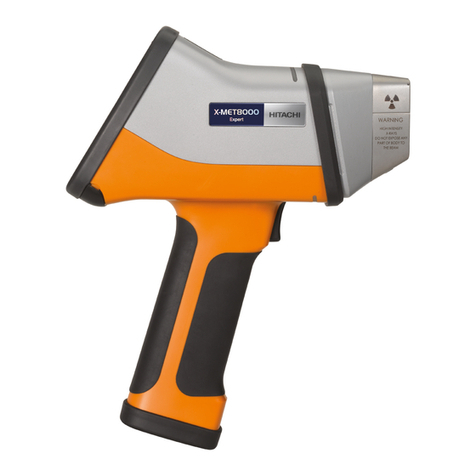
Oxford Instruments
Oxford Instruments X-MET8000 Series Operator's manual
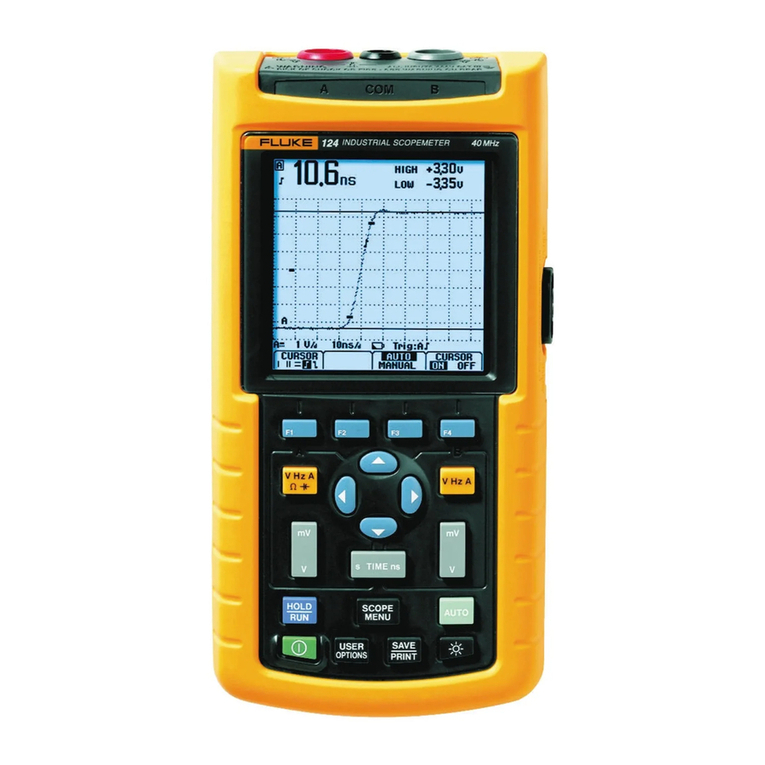
Fluke
Fluke ScopeMeter 123 Getting started
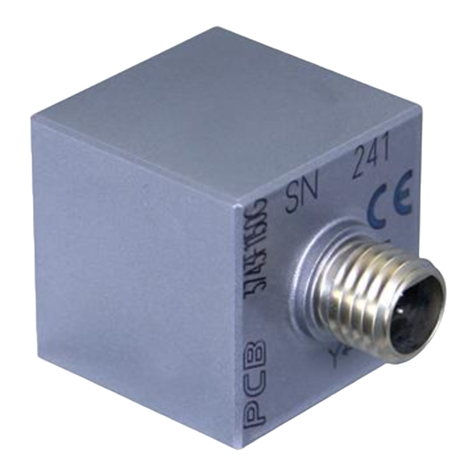
PCB Piezotronics
PCB Piezotronics 3743F112G Installation and operating manual
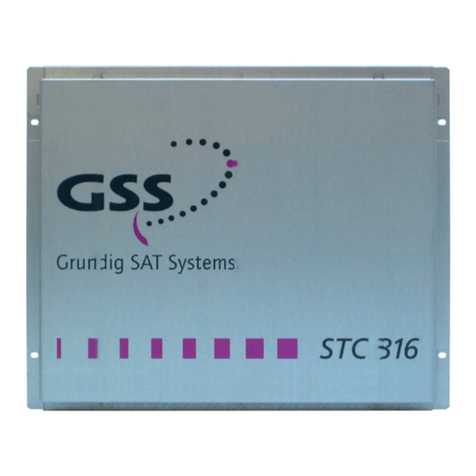
GSS
GSS STC 816 R Assembly instructions
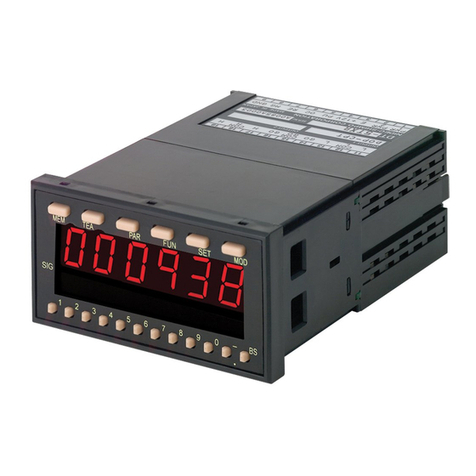
Shimpo
Shimpo DT-5TXR instruction manual

Monacor
Monacor DMT-2505 instruction manual


